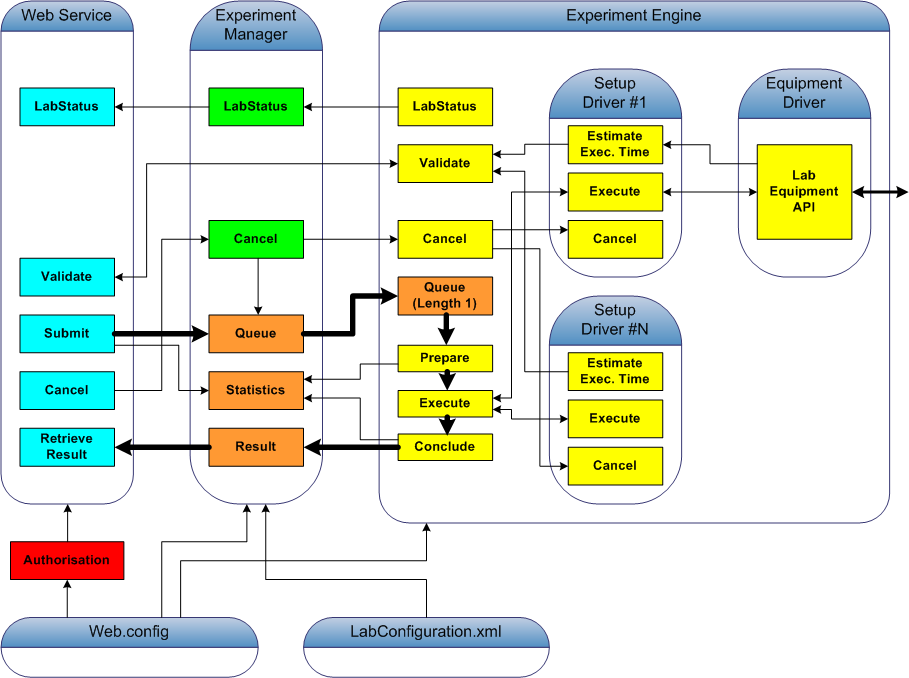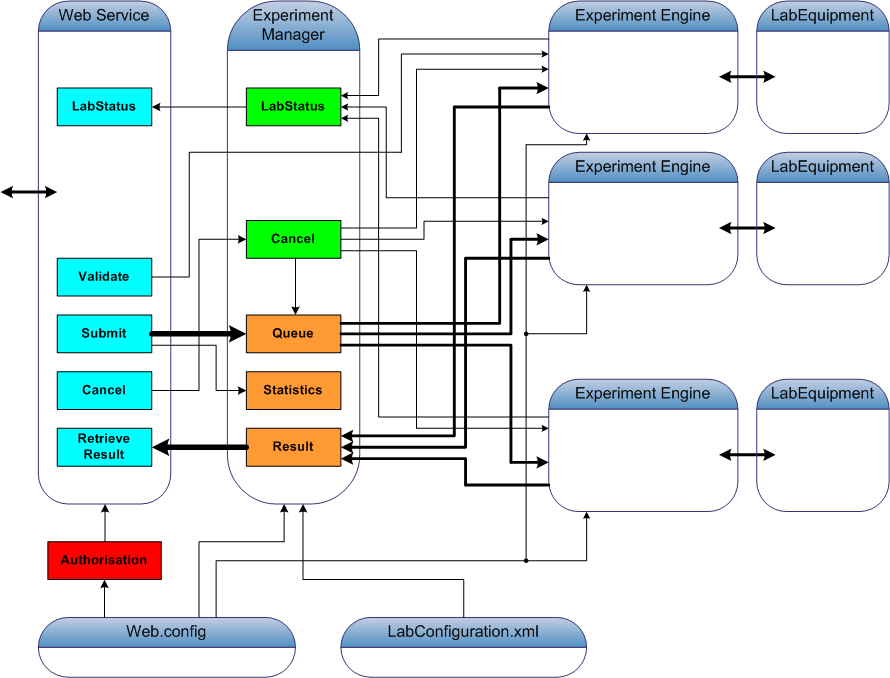iLab Batch LabServer Architecture Overview
Draft - 7 Sep 2009 - LJP
The architecture consists of two parts:
- LabServer – This contains the mechanisms for receiving an experiment specification,
scheduling and running an experiment according to that specification. Communication
with the LabServer is through a web service which implements the iLab ServiceBroker-to-LabServer
API.
- LabEquipment – This implements the control of the physical equipment or hardware
for the experiment. This may or may not exist depending on the type of experiment.
ServiceBroker – This is not part of the LabServer architecture but needs
to mentioned because a LabClient can only communicate with a LabServer via a ServiceBroker.
 Figure 1.
Figure 1.
LabServer
The LabServer is a computer running a web service. The computer may be real or virtual.
The operating system installed may be Microsoft Windows, Linux or Apple Macintosh
(just to name a few). The LabServer source code may be written in any programming
language that supports web services.
 Figure 2.
Figure 2.
The LabServer consists of a number of parts:
- Web Service - When a web service method is called by a ServiceBroker, an
authorisation check is carried out. The SOAP header contains the ServiceBroker’s
GUID and a passkey which are checked against entries in the LabServer’s configuration
file. If the ServiceBroker has authorisation, the web service method passes the
call onto the Experiment Manager for processing.
- Experiment Manager – Responsible for processing web service method calls.
It determines the configuration of the LabServer. It provides the status of the
LabServer, validation results of an experiment specification, and takes a submitted
experiment specification and places it on a queue ready for processing by an Experiment
Engine.
- Experiment Engine – Processes and runs an experiment specification. It validates
an experiment specification by calling upon Setup Drivers, provides the status of
the currently running experiment, and saves the experiment results for retrieval
by a ServiceBroker.
- Setup Drivers – Determine the way in which the experiment specification will
be run on the Experiment Engine. They also provide an estimate of the time required
to run the experiment. Typically, there are multiple setup drivers, e.g., measurements
over time and measurements over distance. The setup drivers call upon Equipment
Drivers to operate the equipment and to get an estimate of the time required to
carry out those operations.
- Equipment Drivers – Provide the interface to the LabEquipment. Operations
required by the setup drivers are converted to commands by the equipment drivers
and sent to the LabEquipment for processing. The commands may be either be sent
to a LabEquipment’s web service or by a TCP/IP connection to the equipment.
LabEquipment
The LabEquipment is a computer running a web service. It has experiment specific
hardware attached and is connected to a private network. The operating system installed
on the computer will depend on the hardware being used.
 Figure 3.
Figure 3.
The LabEquipment consists of the following:
- Web Service - Receives commands from the LabServer and processes them. The
commands may control the equipment or request an estimate of the time required to
control the equipment.
- Hardware Drivers – These are drivers for manufacturer specific equipment
such as an adapter card that plugs into the computer. Equipment could also be attached
to the computer with a USB, serial or network connection.
- Power On/Off – When the equipment needs to perform some function, it can
be powered up and initialised. Then after a period of inactivity, the equipment
can be powered back down again. This is optional, but helps to prevent the equipment
from "wearing out" when it only gets used once or twice per day/week.
Experiment Farming
Suppose that there are multiple identical sets of equipment and they are operated
in exactly the same way, it is not necessary to use seperate LabServers to drive
each set of equipment. If multiple Experiment Engines were created with each servicing
one set of equipment then the Experiment Manager could pass submitted experiment
specifications to each Experiment Engine as they became available to run an experiment.
Effectively, the Experiment Manager creates an array of Experiment Engines and shares
the submitted experiment specifications amongst them. There will still be one Equipment
Service for each Experiment Engine though.
Validation of an experiment specification still needs to be carried in some part
by an experiment engine, but which one? Well, the first one because it will always
be present.
Experiment farming has the effect of reducing the user wait times during peak periods
and also allow the LabServer to continue operation without downtime should any one
set of equipment fail.
 Figure 4.
Figure 4.
 Figure 1.
Figure 1.
 Figure 1.
Figure 1.
 Figure 2.
Figure 2.
 Figure 3.
Figure 3.
 Figure 4.
Figure 4.